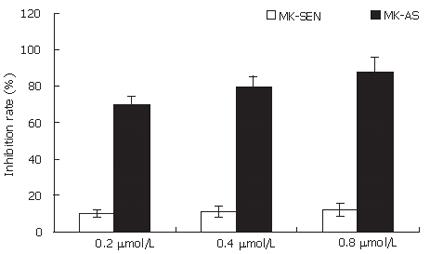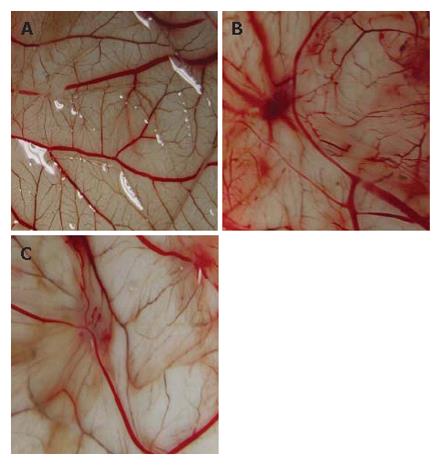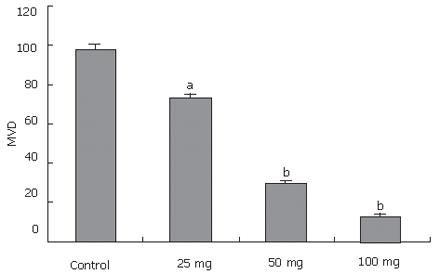Copyright
©2007 Baishideng Publishing Group Co.
World J Gastroenterol. Feb 28, 2007; 13(8): 1208-1213
Published online Feb 28, 2007. doi: 10.3748/wjg.v13.i8.1208
Published online Feb 28, 2007. doi: 10.3748/wjg.v13.i8.1208
Figure 1 RT-PCR (A) and Western-blotting analysis (B) of MK expression in human umbilical vein endothelial cells (HUVEC) after transfection with 0.
4 μmol/L MK-AS (lane 4), MK-SEN (lane 3), Lipofectin alone (lane 2) for 24 h. Lane 1 represents cells without transfection. GAPDH and β-actin were used as control respectively.
Figure 2 Effect of MK on growth of HUVEC.
Cells after transfection with 0.4 μmol/L MK-AS or MK-SEN for 24 h were analyzed by MTS assay. Data were expressed as mean ± SD from four independent experiments.
Figure 3 Angiogenesis in normal chick CAM (A), HepG2-induced CAM (B), and HepG2-induced CAM treated with 0.
4 μmol/L MK-AS (C). Chick CAM assays were used to assess the impact of MK-AS on angiogenesis in vivo.
Figure 4 Immunohistochemical analysis of HCC xenograft angiogenesis after treatment with MK-SEN (A), 25 mg/kg of MK-AS per day (B), 50 mg/kg of MK-AS per day (C), and 100 mg/kg of MK-AS per day (D).
Representative views of anti-CD34 antibody-stained vascular endothelium (brown) (х 200).
Figure 5 Tumors resected from mice at the experimental end point.
Resected tumors were sectioned and stained as described in the text. Microvessel densities (MVD) were determined by counting CD34-positive endothelial cells in the sections and presented as mean ± SE positive cells/field from the three “hot-spot” fields. aP < 0.05, bP < 0.01 vs control group.
-
Citation: Dai LC, Wang X, Yao X, Lu YL, Ping JL, He JF. Antisense oligonucleotide targeting midkine suppresses
in vivo angiogenesis. World J Gastroenterol 2007; 13(8): 1208-1213 - URL: https://www.wjgnet.com/1007-9327/full/v13/i8/1208.htm
- DOI: https://dx.doi.org/10.3748/wjg.v13.i8.1208













